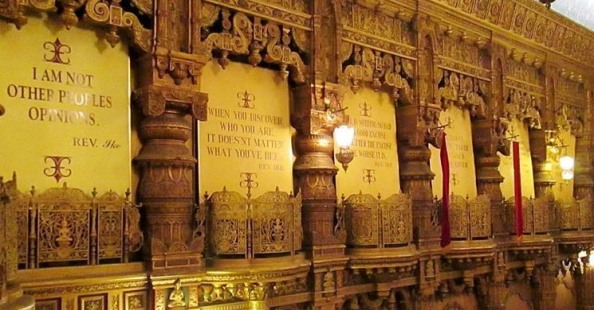The Wonder Theatres were five giant, lavish movie palaces that opened around
New York City in 1929 and 1930. While cinemas were plentiful at the time, the Wonder Theatres were a cut above the rest. Built as Loew’s flagship theatres, the opulent venues were designed with all the fabulousness of the Jazz Age, and went on to provide an escape into the fantasy of Hollywood and luxury throughout the Great Depression and Second World War.

The last of the Wonder Theatres to open was the Loew’s 175th Street Theatre, today known as the United Palace Theater. It debuted on February 22, 1930, with showings of the films Their Own Desire and Pearls and vaudeville performances
starring Al Shaw and Sam Lee. The theater is a sight to behold. The lavish interior, much of which is filigreed, features authentic Louis XV and XVI furnishings and ornate chandeliers, while the blocky exterior is reminiscent of Mayan architecture. Its eclectic architectural style, designed by Thomas W. Lamb, was described by The New York Times as “Byzantine-Romanesque-Indo-Hindu-Sino-Moorish-Persian-Eclectic-Rococo-Deco” and a “kitchen sink masterpiece.” With more than
3,000 seats, it is still the fourth largest venue of its kind in Manhattan.

Movie palaces eventually fell out of vogue, however, and the grand Wonder Theatres fell into decline and abandon in the late 60s and
through the 70s. Today, two of the theaters (the Jersey Theatre in Jersey City and Kings Theatre in Brooklyn) still serve as cinemas and performance venues. Another two (the Paradise Theatre in the Bronx and Valencia Theatre in Queens) became churches.
The United Palace Theater, located in upper Manhattan’s Washington Heights, found a second life as a unique mix of both.

The former Wonder Theatre still functions as a church, as well as a movie house with a 50-foot screen, and a performance venue that has brought in acts as diverse as Adele, Bob Dylan, Iggy Pop, and the Berlin Philharmonic. It also serves as a cultural and community arts center, opened by Reverend Ike’s son Xavier Eikerenkoetter, who now oversees operations of the historic venue.



